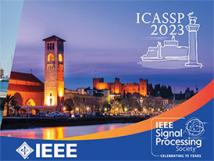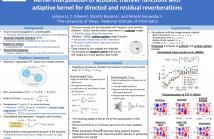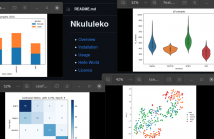
IEEE ICASSP 2023 - IEEE International Conference on Acoustics, Speech and Signal Processing is the world’s largest and most comprehensive technical conference focused on signal processing and its applications. The ICASSP 2023 conference will feature world-class presentations by internationally renowned speakers, cutting-edge session topics and provide a fantastic opportunity to network with like-minded professionals from around the world. Visit the website.

- Read more about Optimize for my Voice with Speaker Identification
- Log in to post comments
The proposed system enhances speech in video-conferencing applications. We aim to improve speech quality and communication clarity in various daily-life scenarios. Our demo will appeal to the ICASSP audience because it is related to the 5th DNS Challenge. The demo aims to enhance audio signal to preserve the primary talker while suppressing neighboring talkers, noise, and reverberation. Besides these challenges, the system automatically controls the level of the primary talker and doesn’t boost return echos or misdetections of noise as speech.
- Categories:
 110 Views
110 Views
- Read more about Kernel interpolation of acoustic transfer functions with adaptive kernel for directed and residual reverberations
- Log in to post comments
An interpolation method for region-to-region acoustic transfer functions (ATFs) based on kernel ridge regression with an adaptive kernel is proposed. Most current ATF interpolation methods do not incorporate the acoustic properties for which measurements are performed. Our proposed method is based on a separate adaptation of directional weighting functions to directed and residual reverberations, which are used for adapting kernel functions. Thus, the proposed method can not only impose constraints on fundamental acoustic properties, but can also adapt to the acoustic environment.
- Categories:
 35 Views
35 Views
- Read more about Efficient Feature Extraction for Non-Maximum Suppression in Visual Person Detection
- Log in to post comments
poster.pdf
- Categories:
 17 Views
17 Views
- Read more about FAST SINGLE-PERSON 2D HUMAN POSE ESTIMATION USING MULTI-TASK CONVOLUTIONAL NEURAL NETWORKS
- Log in to post comments
This paper presents a novel neural module for enhancing existing fast and lightweight 2D human pose estimation CNNs, in order to increase their accuracy. A baseline stem CNN is augmented by a collateral module, which is tasked to encode global spatial and semantic information and provide it to the stem network during inference. The latter one outputs the final 2D human pose estimations.
2023041536.pdf
- Categories:
 17 Views
17 Views
- Read more about An Efficient Beam-Sharing Algorithm for RIS-aided Simultaneous Wireless Information and Power Transfer Applications
- Log in to post comments
Simultaneous wireless information and power transfer (SWIPT) is a key technology for enabling future high-tech lifestyles by guaranteeing the perpetual operation of trillions of low-power IoT devices. Currently, reconfigurable intelligent surface (RIS) is a promising technology for achieving cost-effective and energy-efficient wireless technologies. In this paper, we propose an efficient beam-sharing algorithm for RIS-aided SWIPT systems.
- Categories:
 18 Views
18 Views
- Read more about An Efficient Beam-Sharing Algorithm for RIS-aided Simultaneous Wireless Information and Power Transfer Applications
- Log in to post comments
Simultaneous wireless information and power transfer (SWIPT) is a key technology for enabling future high-tech lifestyles by guaranteeing the perpetual operation of trillions of low-power IoT devices. Currently, reconfigurable intelligent surface (RIS) is a promising technology for achieving cost-effective and energy-efficient wireless technologies. In this paper, we propose an efficient beam-sharing algorithm for RIS-aided SWIPT systems.
- Categories:
 19 Views
19 Views
- Read more about Alternating Constrained Minimization based Approximate Message Passing
- Log in to post comments
Generalized Approximate Message Passing (GAMP) allows for Bayesian inference in linear models with non-identically independently distributed (n.i.i.d.) priors and n.i.i.d. measurements of the linear mixture outputs. It represents an efficient technique for approximate inference, which becomes accurate when both rows and columns of the measurement matrix can be treated as sets of independent vectors and both dimensions become large.
- Categories:
 25 Views
25 Views
- Read more about Image Reconstruction Without Explicit Priors
- Log in to post comments
We consider solving ill-posed imaging inverse problems without access to an explicit image prior or ground-truth examples. An overarching challenge in inverse problems is that there are many undesired images that fit to the observed measurements, thus requiring image priors to constrain the space of possible solutions to more plausible reconstructions. However, in many applications it is difficult or potentially impossible to obtain ground-truth images to learn an image prior. Thus, inaccurate priors are often used, which inevitably result in biased solutions.
- Categories:
 23 Views
23 Views
- Read more about Chord-Conditioned Melody Harmonization with Controllable Harmonicity
- Log in to post comments
Melody harmonization has long been closely associated with chorales composed by Johann Sebastian Bach. Previous works rarely emphasised chorale generation conditioned on chord progressions, and there has been a lack of focus on assistive compositional tools. In this paper, we first designed a music representation that encoded chord symbols for chord conditioning, and then proposed DeepChoir, a melody harmonization system that can generate a four-part chorale for a given melody conditioned on a chord progression.
- Categories:
 12 Views
12 Views
- Read more about Nkululeko
- Log in to post comments
We would like to present Nkululeko, a template based system that lets users perform machine learning experiments in the speaker characteristics domain. It is mainly targeted on users not being familiar with machine learning, or computer programming at all, to being used as a teaching tool or a simple entry level tool to the field of artificial intelligence.
- Categories:
 25 Views
25 Views